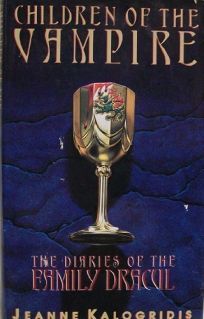
Lord of the Vampires, by Jeanne Kalogridis
(The Diaries of the Family Dracul, Book Three)
© 1996 Dell Publishing
Jeanne Kalogridis' capstone to her Diaries trilogy takes place concurrently with the events of Bram Stoker's Dracula. In fact, Lord of the Vampires offers an entirely new take on many of the events of that famed seminal novel of vampire fiction, providing more than just new insights on Stoker's existing canon, but entirely new, previously-unseen aspects, characters, and plot-points.
Well, perhaps "entirely new" is a bit of an overstatement. Kalogridis never adds completely new characters out of whole cloth; she has too much respect for Stoker to do that. Instead, she dramatically expands on what were previously unnamed background characters -- such as Dracula's three "brides" or Van Helsing's mysterious friend Arminius -- fleshing them out into fully-rounded characters with their own psychologies, motivations, and story arcs. As a result, we see Dracula, which was already a novel of many viewpoints, from the points of view of new characters, or from the same characters but with new information: for instance, we learn that Dr, Seward's wax cylinder dictations, which comprise his contributions to the original novel, only told part of what he knew. Here, Kalogridis makes us privy to his private, hand-written journals, which reveal that he (and his mentor, Prof. Van Helsing), know considerably more about vampirism in general and Vlad Dracul in particular, than the original novel suggested.
 |
| Professor Abraham Van Helsing, MD, D.Ph., D.Litt., etc, etc. |
By writing a novel that takes place within the events and context of another novel -- and an extremely famous one at that -- Kalogridis has taken on the difficult task of trying to surprise her readers while telling them a story they've heard many times before, without changing too much of the story or introducing elements which break her audience's suspension of disbelief. If she adheres to Stoker's plot too slavishly, the audience will get bored; if she changes things too much, they'll get angry and defensive. Fortunately, Kalogridis manages to strike a delicate balance between old and new, crafting a tale which manages to bring us back to familiar ground while simultaneously making it seem new and exciting.
Lord of the Vampires introduces something new to the series: a sense of pathos, of real human suffering. Not just supernatural cruelty (though there is plenty of that), but a peek into the houses of the dying. Early on we learn that Van Helsing's mother, Mary Windham-Tepesh, is dying of cancer, and we see in intimate detail just how devoted her son is to caring for her through even the most piteously gruesome aspects of late-stage cancer. Much attention is lovingly paid to the mood in the Westenra household as Lucy lies dying: we see the heartache and the pain which it brings, but as Van Helsing observes: "in the midst of gloom shines a ray of love and valour. . . . the experience [of caring for a mortally ill family member] melts away the more superficial aspects of the personality, revealing a golden core of strength and compassion."
 |
| Pictured: One bad mofo |
In some ways, Lord of the Vampires is like those episodes of Game of Thrones that diverge from the books they're based on: what seemed predictable is suddenly no longer following the path which we expected, and this creates cognitive dissonance and dramatic tension. What was once familiar is suddenly, disconcertingly unfamiliar. Although it's sometimes a little maddening to see Van Helsing or Zsuzsanna being secretly present in familiar scenes yet unwilling to do anything to change their outcomes (for reasons which seem flimsy at best), Lord of the Vampires is overall an interesting second-take on a very well-known story, which forces us to pause and reconsider whether we actually know it all that well (or whether we know the whole truth of it). Many have commented about the logical inconsistencies of Dracula ( the vampire's inconsistent powers and weaknesses, his abysmal impulse-control, Van Helsing's shocking willingness to leave Mina undefended and ignorant of the truth), and this book does go a long way towards explaining some of these decisions, as well as providing more insight into the psychology and motivations of one of literature's greatest villains.































/cdn.vox-cdn.com/uploads/chorus_image/image/50136907/103_013r.0.jpg)
